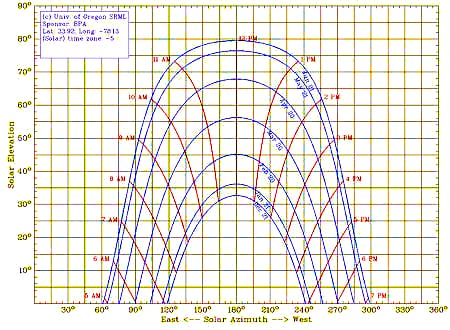There is a lot of information available about the light intensity needs of plants, so when purchasing grow lights, it is a relatively simple matter to specify the wattage we will need for our grow areas. However, if we are looking to supplement natural sunlight or determine how much shade we need for a greenhouse, it would help if we knew just how much natural sunlight intensity we have to work with in the first place.
At the equator, the sun’s intensity gives us a Photosynthetic Photon Flux Density (PPFD) of 2000 µmol/m2/sec of light, which is roughly equivalent to 10,200 foot candles or 108,000 lux. As we move away from the equator however, the relative thickness of the atmosphere the light must travel through increases, and the angle of incidence “spreads out” the light, both of which decrease the light intensity. Not only does our location affect the sunlight intensity, but the time of year does, as well, as the sun is lower in the sky in winter than in summer. Fortunately, there are some simple tools that can help.
The University of Oregon Solar Radiation Monitoring Laboratory has an online Sun Chart Program that allows us to generate a solar elevation chart for your specific location, providing data for month of the year, as well as time of day. The chart for your location will look something like this:

From this chart we can see, for example, that at noon on December 21st, for this specified location, the sun will only reach a maximum of 33° in elevation, while on June 21st, it can reach 80°.
Unfortunately, the relationship between solar elevation and solar intensity is a sine function and not a linear one. Fear not! By simply generating your own Sun Chart and entering the solar elevation (in degrees) in the calculator below, the maximum light intensity possible is provided.
So you can see that for this location, the maximum summer sunlight intensity is about 1970 µmol/m2/sec, or only about 1.5% below that of the equator, while in winter it’s only 1090 µmol/m2/sec, or 45% less.